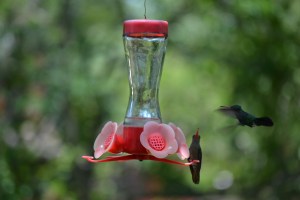
This animal “salad” was made with wood pieces. Included because my blog is on wildlife!
Restoring my family house in Carmelo, Uruguay is an important ingredient -together with blogging- prescribed by my children to delay the dreaded brain paralysis and avoid terminal boredom due to retirement. The closest hardware shop became a very frequented place as I was constantly looking for tools and materials needed for the task. To my satisfaction, I discovered that a new shop had been opened just fifty metres from my house and I visited it
The shop -that also sells house ware and ornaments- belongs to José (Pepe) and Rosa Castro. The latter takes care of it and deals with customers. They have a teenager son called Alexandro. After a few visits I met Pepe and we gradually got to know each other. He was -rather unusually- interested in my life in Africa and I listened to what he did. We lied to each other a lot and we knew it! One day Pepe convinced me to linger a few minutes so he could show me his work. I luckily accepted and I was privileged to gain a glimpse of his life’s achievement.

Noah’s Ark.
I am aware that by writing this post I am completely deviating from the usual wildlife-related topics and that I am entering a territory I know little about. I hope you find this interesting. In any case, I promise you that my next post will be on the usual nature-related subject (what else?).
Pepe was born in Pontevedra, Spain 75 years ago and arrived in Uruguay in 1957. He worked as a cabinetmaker (“ebanista” in Spanish) in some of the finest furniture makers in Montevideo for many years while he studied technical and artistic drawing and various painting techniques. He started sculpting in 1965 and he gradually increased his output until his retirement when his life became almost solely focused on his work. More details can be found
http://www.escultorjosecastro.com/index.
As a veterinarian and a scientist the understanding of art is not my thing and not even several years in Rome managed to change this too much. For this reason I like what I like but I can also appreciate the work that goes into creating works of art! In Pepe’s case, despite being “brain-impaired” when it comes to art, I not only like a lot of what he did (and does) but also appreciate the work involved in achieving it!

What can I say? Its title is “Climbing”.
I learnt that, so far, Pepe has created over eight hundred pieces (carvings, artistic chairs, wood panels, boxes and other items) and I could see several styles although I am unable to comment or seriously criticize them!

HIs creativity outruns storage space!
Fortunately, as he got to know me, he started to show me his work and to explain it to me. To be able to look at art with the creator showing it to you is out of this world and I felt -aware of the possible differences- like a friend of Picasso being able to question him about details of his masterpieces!
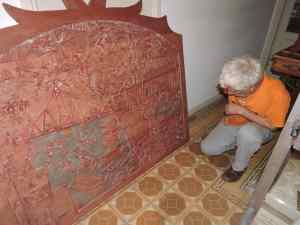
Pepe explaining a work about Carmelo.
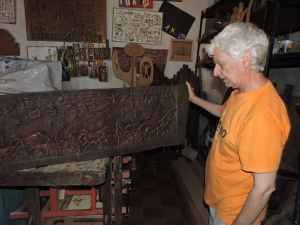
Pepe describing another piece.
Pepe has exhibited his work several times, he has been the subject of interviews and published accounts of his work also exist. Leafing through these I learnt that his style of work is defined as “Baroque” and that many of them deal with his life experiences and/or tell a story. Some of his works are so elaborate and full of detail that it takes several examinations to fully take in their meaning and detail.

Several pieces represent episodes of Pepe’s life. This is a “haunted” house he secretly visited as a child.
Since meeting him I have now talked to Pepe a great deal and also watched him working. Although he appears lighthearted and funny most of the time, when it comes to his work he transforms himself into a different man, guided by his inspiration and aims for almost impossible perfection! However, he transmits his mischievous view of life into his work that often has a jocose element in it that can become satiric in several of his works (keep reading!).
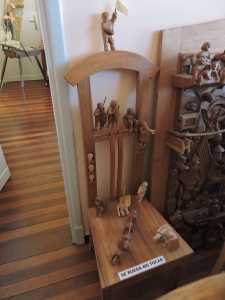
A great chair is not enough for Pepe.
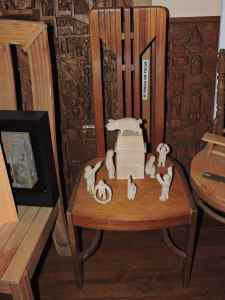
Another example of a chair according to Pepe…
One day he called me, as he had to show me “something”. He took me to his workshop and, seeing it for the first time, I was really impressed. It is inside his “Cave” as he calls his workshop, that Pepe becomes the artist. “It is here that I feel really comfortable, it gives me pleasure, I have fun, I play”. This is his secret kingdom and where his ideas get transformed into art. It is also here that he keeps a vast collection of carpentry tools that are his pride and joy and are worth seeing.
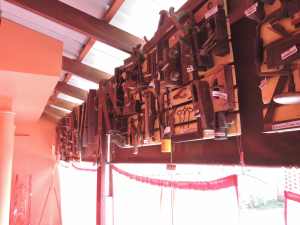
Pepe’s tool collection.
Once inside the Cave I noticed many pieces of wood and roots of several types, origins and shapes that are patiently waiting until Pepe decides to gives them the life or death he “sees” for them. In some, the final output is starting to emerge as Pepe works his way through them.

Inside his “Treasure Cave”.
I spotted a large tree trunk base with its roots still attached, to which he has wrapped carved branches and sticks of different colours. Questioned about it he said “I am looking at it and considering several options. I do not know yet. I have about ten ideas. The one on the surface at the moment is to place dwarfs peering through its holes. I do not know yet but it will be something creepy”.
Then he picked up another piece and starts to showed it to me. “Look” he said, “there is a tail here and a leg there” and suddenly, but only for a fleeting moment, I began to see what he saw. And then he said, “it is not a normal animal, it is some kind of a creature” and then he loost me again as I stayed with the tail and the leg and my conventional animal! Only then I managed to recognize the burnt and dirty dried fig tree we collected together!

A simple dried and half-burnt root (collected together) starts to gain shape.
When I told him, he laughed and moved on to show me the twelve “special” dining chairs he is making or his on-going depiction of the execution of another creature in the electric chair. “The victim will not be normal, it will be a being or something but I do not yet know” he said, and then added “it will be tied to the chair”.

Pepe showing me another piece. The electric chair project to his left.
We walked through his house where his finished work is displayed. He said, “When the conditions are right, I would like to start a Foundation where not only I can display my work but also teach the young generations”. I can only silently hope that he succeeds and promise myself to help him in achieving his dream. Watching his finished works I can see that -like other artists- he can do what I consider to be “conventional” and beautiful sculptures as well as wonderful chairs that he decorates with his own unique creations of many shapes and forms.
As he knows my animal preferences and he picked a simple cow from a shelf to explain that he left it partly undone so that people could see it in different ways. It is however clear that he put great detail into it as, for instance, the milk vein is clearly there!
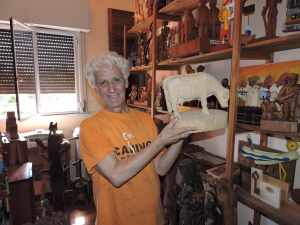
“Do not bother me, it is just a cow”
Some of his work I can understand (and admire) straight away (although more careful observation reveals more detail). Among these is the “Babel Tower” and “Noah’s Ark”. Even the clear animal suffering that “Extinction” depicts is evident to me as its subjects really reflect the agony of their fate! Other work passes over my head and it is only after Pepe’s patient explanations and comments that I start seeing things and interpreting what he means.

“Extinction”
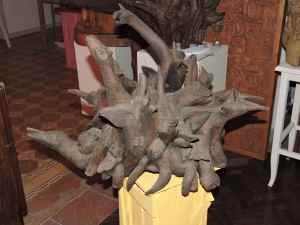
“Extinction” from another angle.
I see several styles, elaborate carvings, combinations of wood and paint -my favourites- and others. Clearly “Climbing” at its near two metres tall is one of his greatest achievements but there are others that although smaller are no less magnificent: wooden boxes that fit into each other like Russian dolls, colourful wooden “cubistic” jigsaw puzzles made of wood trimmings, old silk thread cabinets filled with carved world famous figures many of whom you can easily recognize as you do with the five Uruguayan politicians that he wickedly calls “Four Politicians”!
Some works follows the options that a piece of wood offers, but in others the wood follows what Pepe wants to get out of it. I think this simply depends on the mood and will power he has on the day he chooses to work them!
We talked so much and I became so engrossed in his work that I got back home brain dead but happy to have spent time with him and to have a few -rather poor- pictures to illustrate the post. However, I also notice that I never saw what he wanted to show me in the first place! I decided to visit him the next day.
So the following day I returned and he showed me the piece. It is a wooden cabinet and when he starts opening it his wicked side takes over and, before I see it, I understand. I am in it, together with him and a crocodile inside a cauldron and surrounded by animals and African people. Somehow all my pestering of Pepe about Africa has curdled into art, even if clearly tongue in cheek. I am proud of being part of his work, although shown in rather uncomfortable circumstances… However, I now join the ranks of Don Quijote, Jesus, God and the Devil among others depicted in his works!
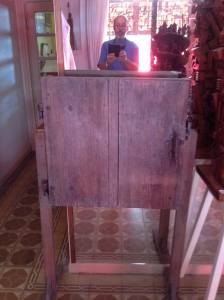
A simple old cabinet…

Opening the cabinet reveals its sinister contents… (The Bushsnob is also shown above for reference purposes)


















![Armour_of_glyptodon - Copy A complete Gliptodon carapace. Credit: Kuruc at en.wikipedia [Public domain], via Wikimedia Commons.](https://i0.wp.com/bushsnob.com/wp-content/uploads/2017/04/armour_of_glyptodon-copy.jpg?w=410&h=307&ssl=1)
![Glyptodon_asper_armor - Copy A detail of the carapace showing the osteoderms. Credit: LadyofHats [Public domain], via Wikimedia Commons.](https://i0.wp.com/bushsnob.com/wp-content/uploads/2017/04/glyptodon_asper_armor-copy.jpg?w=202&h=152&ssl=1)


























